and RE/MAX Preferred
Your NJ Results Team!
With multiple offices to better serve you.
LawrenceYerkes.com
Office: 609-654-7300 x1024
Direct: 609-975-9230
Fax: 609-654-7060

|
|
|
H. LAWRENCE
YERKES and RE/MAX Preferred Your NJ Results Team! With multiple offices to better serve you. |
LawrenceYerkes.com |
 |
| Home | Back | Sell | Buy | Rent |Search | Relocate | Resources | Contact Me | Site Map | Translate |

Septic Systems - Homeowner Maintenance
[Return to Main Articles Index]
Did you know that about 25 percent of the U.S. population relies on decentralized—or onsite—wastewater treatment systems? About 95 percent of the onsite wastewater disposal systems are septic systems.
What is a septic system?
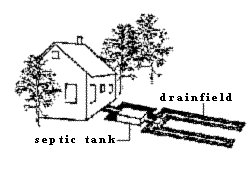 A septic system is a highly efficient, self-contained, underground wastewater treatment system. Because septic systems treat and dispose of household wastewater onsite, they are often more economical than centralized sewer systems in rural areas where lot sizes are larger and houses are spaced widely apart. Septic systems are also simple in design,
which make them generally less expensive to install and maintain. And by using natural processes to treat the wastewater onsite, usually in a homeowner's backyard, septic systems don't require the installation of miles of sewer lines, making them less disruptive to the environment.
A septic system is a highly efficient, self-contained, underground wastewater treatment system. Because septic systems treat and dispose of household wastewater onsite, they are often more economical than centralized sewer systems in rural areas where lot sizes are larger and houses are spaced widely apart. Septic systems are also simple in design,
which make them generally less expensive to install and maintain. And by using natural processes to treat the wastewater onsite, usually in a homeowner's backyard, septic systems don't require the installation of miles of sewer lines, making them less disruptive to the environment.
A septic system consists of two main parts-a septic tank and a drainfield. The septic tank is a watertight box, usually made of concrete or fiberglass, with an inlet and outlet pipe. Wastewater flows from the home to the septic tank through the sewer pipe. The septic tank treats the wastewater naturally by holding it in the tank long enough for solids and liquids to separate. The wastewater forms three layers inside the tank. Solids lighter than water (such as greases and oils) float to the top forming a layer of scum. Solids heavier than water settle at the bottom of the tank forming a layer of sludge. This leaves a middle layer of partially clarified wastewater.
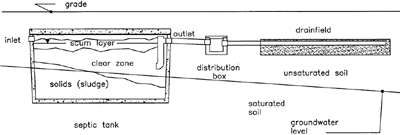
The layers of sludge and scum remain in the septic tank where bacteria found naturally in the wastewater work to break the solids down. The sludge and scum that cannot be broken down are retained in the tank until the tank is pumped. The layer of clarified liquid flows from the septic tank to the drainfield or to a distribution box (D-box), which helps to uniformly distribute the wastewater in the drainfield. The distribution box may be attached directly to the septic tank or connected to it by a short length of pipe. A standard drainfield (also known as a leachfield, disposal field, or a soil absorption system) is a series of trenches or a bed lined with gravel or course sand and buried one to three feet below the ground surface. Perforated pipes or drain tiles run through the trenches to distribute the wastewater. The drainfield treats the wastewater by allowing it to slowly trickle from the pipes out into the gravel and down through the soil. The gravel and soil act as biological filters.
Septic Systems Maintenance for the Homeowner
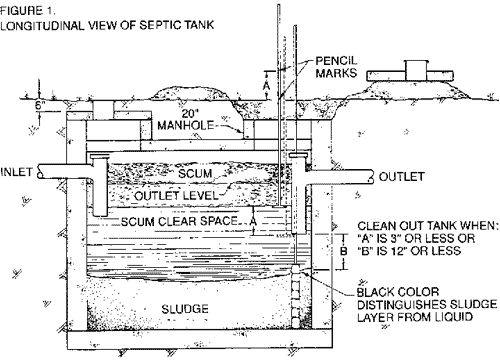
If you own a septic system, it is important that it be properly maintained. How often you need to pump the solids out of your septic tank depends on three major factors:
Although your septic tank absorption field generally does not require maintenance, you should adhere to the following rules to protect and prolong its functional life:
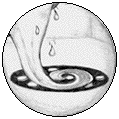 |
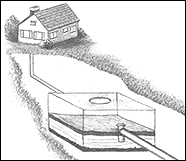 |
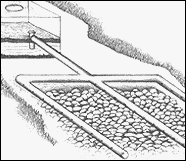 |
Septic Tank Maintenance
Homeowners wanting to take good care of their septic systems should make note of the following items that should never be flushed down the drain or toilet. These items can overtax or destroy the biological digestion taking place within the system or clog pumps and pipes.
Take care not to flush the following:
and NEVER flush chemicals that could contaminate surface and groundwater, such as:
The National Small Flows Clearinghouse (NSFC) offers a series of brochures about septic system operation and maintenance. These brochures describe how septic systems work and give some general guidelines to help protect the groundwater and prolong the life of your septic system.
Source: NSFC - Septic Information
How often should you pump your septic tank?
As a rule of thumb, many experts
recommend cleaning out an average septic tank at least every 3 to 5
years. However, use the chart below to determine what is better for your
specific level of usage and tank size.
Time Table for Inspecting and Pumping Your Septic Tank (in years):
1
2
3
4
5
6
7
8
9+
Tank Size (gals)
500
5.8
2.6
1.5
1.0
0.7
0.4
0.3
0.2
0.1
750
9.1
4.2
2.6
1.8
1.3
1.0
0.7
0.6
0.4
900
11.0
5.2
3.3
2.3
1.7
1.3
1.0
0.8
0.7
1000
12.4
5.9
3.7
2.6
2.0
1.5
1.2
1.0
0.8
1250
15.6
7.5
4.8
3.4
2.6
2.0
1.7
1.4
1.2
1500
18.9
9.1
5.9
4.2
3.3
2.6
2.1
1.8
1.5
1750
22.1
10.7
6.9
5.0
3.9
3.1
2.6
2.2
1.9
2000
25.4
12.4
8.1
5.9
4.5
3.7
3.1
2.6
2.2
2250
28.6
14.0
9.1
6.7
5.2
4.2
3.5
3.0
2.6
2500
31.9
15.6
10.2
7.5
5.9
4.8
4.0
3.5
3.0
For example, if there are 4 people living in your house and your septic tank can hold 1,000 gallons, the tank should be inspected and pumped at least every three years.
Source: Adapted from "Estimated Septic Tank Pumping Frequency," by Karen Mancl. 1984. Journal of Environmental Engineering. Volume 110, via http://h2osparc.wq.ncsu.edu/info/farmassit/f_septic.html.
Additional Resources:
Septic Systems and Their Maintenance - Maryland Cooperative Extension
Your Septic System - Univ. of Fl.
Septic System Owner's Guide - NCSU (PDF file)
Private Septic Systems and Inspection Certifications -- What They Are and Are Not
RESIDENTIAL, COMMERCIAL, INVESTMENT
LAND, FARM,
PROPERTY MANAGEMENT
Global Relocation and Referral Services
Personal * Service * Support * Professionalism * Integrity
Providing friendly dedicated service
- customized to your needs.
Using state-of-the-art methods to find the right property for you
and/or sell your property at the best possible price.
Copyright © 2022 by Lawrence Yerkes
All Rights Reserved
RE/MAX and Logo are trademarks of RE/MAX
International, Inc.
| Home | Back | Sell | Buy | Rent |Search | Relocate | Resources | Contact Me | Site Map | Translate |